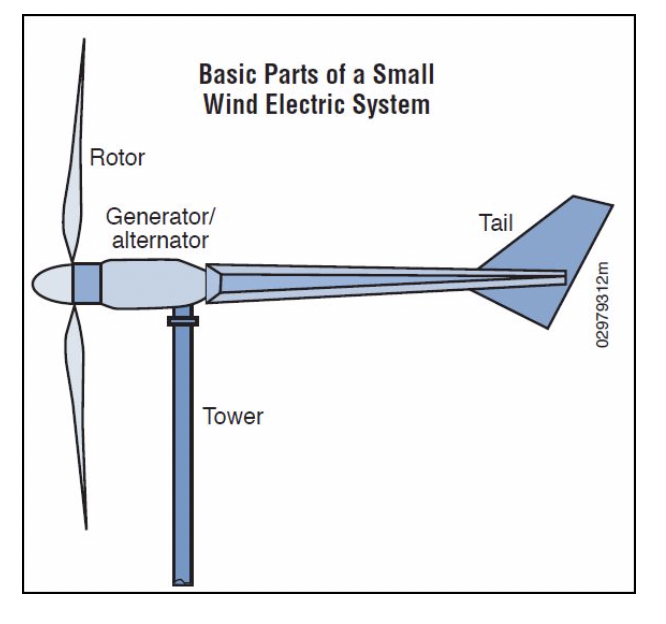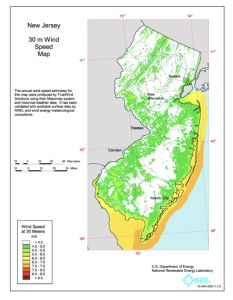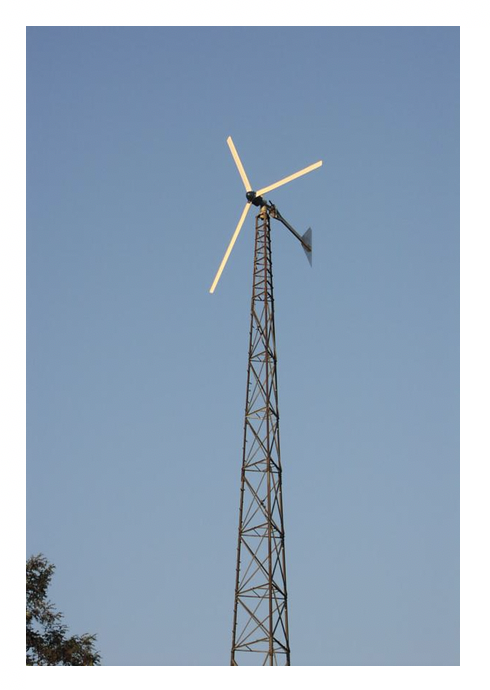On-Site Wind Energy Systems
New CommercialWhat are On-Site Wind Energy Systems?
On-site wind energy systems provide renewable energy in areas with sufficient wind speed. Prime locations for harvesting wind energy in New Jersey are along the shore.[1]
The two main types of wind turbines include horizontal axis wind turbines (HAWT), the most common, and vertical axis wind turbines (VAWT).[2] Initially designed to be mounted on high poles in open or rural areas, small wind turbines (SWTs) include systems that are 100 kilowatts (kW) or less. Small wind energy systems can either be stand-alone (e.g., not connected to the utility grid) or grid-connected. Built-environment wind turbines (BEWT) refer to projects constructed on, in, or near buildings.[3] The highly turbulent and variable wind directions often found in the built environment make VAWTs a viable option for these types of locations as VAWTs do not need to orient into the wind to generate power.[4] VAWTs come in two different designs: the Savonius design, which generates power through drag, and the Darrieus, which generates power through an aerodynamic lift.[5]

Figure 1. Small Wind Electric System (Source: US NREL).

Figure 2 – Illustration of turbine installation in the built environment. Side mounted to the building, roof mounted, ground mounted in the built environment, building integrated (source: US NREL).
How to Implement an On-site Wind Energy System
Renewable energy systems such as wind energy systems are complex and require project team members with on-site wind energy expertise. The US DOE’s Federal Energy Management Program’s Guide to Integrating Renewable Energy in Federal Facilities offers advice on understanding renewable energy options, selecting appropriate types of renewable energy technologies, and integrating these technologies into all project phases. For implementation in New Jersey, project teams should contact the NJ Office of Clean
Energy to learn about current programs, tools, and available funding. Critical project-specific variables to consider include location, space, energy costs, available project incentives, local net metering and interconnection policies. Pre-implementation steps for an on-site renewable energy system project comprise preliminary screening, a renewable energy feasibility study, sizing and design of systems. [6] For example, siting turbines on the highest elevation on the site often correspond to the highest, unobstructed wind speeds. Wind speed increases with height, and small increases in speed boost a turbine’s generating-potential significantly.[7]

Figure 3 – Wind Speed Map at 30 meters (Source: US DOE | NREL – Wind Powering America).
Examples
Jersey Atlantic Wind Farm, Atlantic City, NJ.
The Jersey-Atlantic Wind Farm, a community-scale wind turbine installation, includes five, 380-foot turbines, producing a combined 7.5 megawatts of power. The wind turbines and on-site solar installation power the wastewater treatment plant, with surplus energy sent to the grid.
This study looks at several case studies of Built Environment Wind Turbines (BEWTs), documenting mixed-results in the BEWT industry. Main obstacles cited include, 1) insufficient and not well-defined project feasibility and planning processes, 2) high-cost projects related to additional expenses for installation and operations in the built environment, 3) a lack of certified manufacturers for ongoing service and parts, and 4) over-estimated project performance due to the complexity of conducting accurate resource and production assessments in the built environment. BEWT projects with the best outcomes had well developed and quantified project goals that included energy production as well as educational and sustainability marketing goals. These projects also conducted thorough feasibility investigations, used certified HAWTs with a proven track record, and were installed on tall buildings relative to surrounding obstacles.
Benefits
Wind power reduces dependence on carbon-intensive fuels such as coal.[8] Generating power from wind reduces greenhouse gas (GHG) emissions and promotes the renewable energy industry in New Jersey.
Costs

Figure 4 – A 10 kW wind turbine atop a lattice tower at Hamilton College, NY. (Source: Fortis Wind Energy).
Rebates and tax credits base wind power incentives on expected energy production, rather than capacity. Commercial businesses or organizations may be eligible for the renewable Production Tax Credit (PTC), which provides a $0.019 per kilowatt-hour (kWh) benefit in 2017 (which is phased out over 2018 and 2019) for the first ten years of a renewable energy facility’s operation.[9]
In New Jersey, between 2002 and 2013, wind turbine installation costs ranged from $19,000 for a 1 MW municipal project to $3.3 million for the ACUA Wind Farm in Atlantic City.[10] Nationwide, small wind turbines cost between $800/kW and $1100/kW and a typical 2 MW project costs between $1.6 and $2.2 million[11]. Necessary fees include utility company fees, township and county permits, and installation, accounting for about 4% of the total project cost.[12]
Depending on the strength of the wind resource and the cost of the system, the typical paybacks range from 6-15 years.
Resiliency
On-site wind energy systems rely on wind, a site-based resource and may operate independently from the power grid. Installed with additional hardware—including transfer switches, critical load panels, and appropriate controls—these systems can act as self-sufficient microgrids, generating energy and powering critical loads in the absence of utility sourced power. Wind energy systems provide additional protection from flooding events, based on elevated installations.
[1] American Wind Energy Association. “Wind 101: Wind Energy Basics.” https://www.awea.org/wind-power-101 (accessed April 11, 2018).
[2] WBDG. Wind Technology. https://www.wbdg.org/resources/wind-technology (accessed April 19, 2018).
[3] Jason Fields, Frank Oteri, Robert Press, and Ian Baring-Gould (2016) National Renewable Energy Laboratory. Deployment of Wind Turbines in the Built Environment: Risks, Lessons, and Recommended Practices https://www.nrel.gov/docs/fy16osti/65622.pdf (accessed April 20, 2018).
[4] J. Smith, T. Forsyth, K. Sinclair, and F. Oteri. (2015) NREL. Built-Environment Wind Turbine Roadmap. https://www.nrel.gov/docs/fy13osti/50499.pdf (accessed April 20, 2018).
[5] WBDG. Wind Technology. https://www.wbdg.org/resources/wind-technology (accessed April 19, 2018).
[6] US Dept of Energy’s (DOE) Federal Energy Management Program (FEMP). Guide to Integrating Renewable Energy in Federal Construction. https://www.wbdg.org/FFC/DOE/DOECRIT/re_construction_guide.pdf (accessed May 8, 2018).
DOE. Small Wind Guidebook. https://windexchange.energy.gov/small-wind-guidebook#parts (accessed April 11, 2018).
[8] McCollum, David, and Christopher Yang. 2009. “Achieving deep reductions in US transport greenhouse gas emissions: Scenario analysis and policy implications.” Energy Policy 37: 5580-5596.
[9] US DOE. Renewable Energy Production Tax Credit. https://www.energy.gov/savings/renewable-electricity-production-tax-credit-ptc (accessed April 18, 2018).
[10] NJCEP. Installation and Project Status Reports (REIP and CORE Programs). http://njcleanenergy.com/renewable-energy-archive (accessed April 18, 2018).
[11] US DOE. 2016 Wind Technologies Market Report. https://www.energy.gov/sites/prod/files/2017/10/f37/2016_Wind_Technologies_Market_Report_101317.pdf (accessed April 18. 2018).
[12] Pacific Northwest National Lab (PNNL). Benchmarking US Small Wind Costs. https://wind.pnnl.gov/pdf/Benchmarking_US_Small_Wind_Costs_092817_PNNL.pdf (accessed April 18, 2018).
Related Strategies
Resources
General information and Starting Up
US Department of Energy
NJ Clean Energy Program
Technical Guidance
US Department of Energy
- Small Wind Guidebook
- Northeast Wind Resource Center
- NREL Deployment of Wind Turbines in the Built Environment: Risks, Lessons, and Recommended Practices
